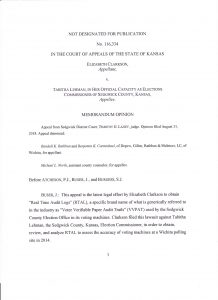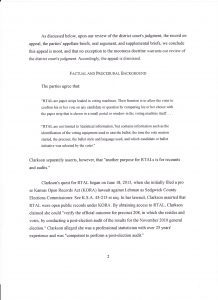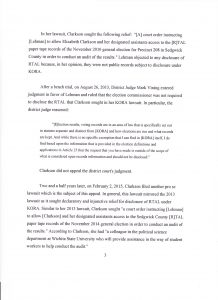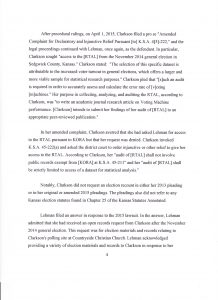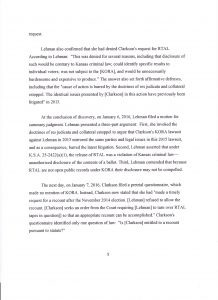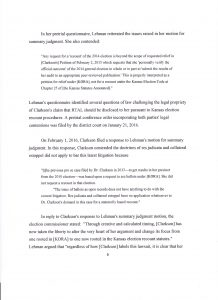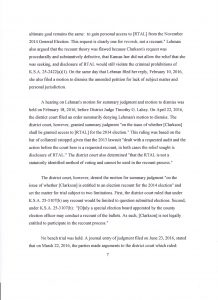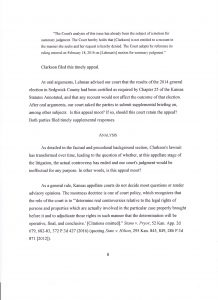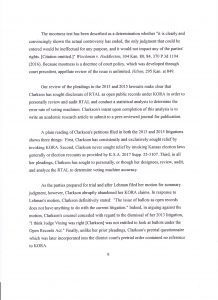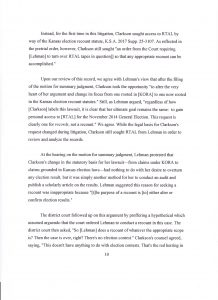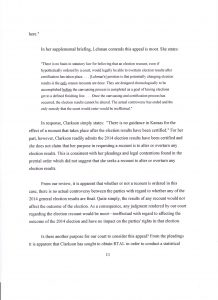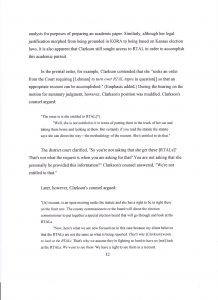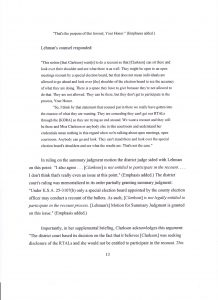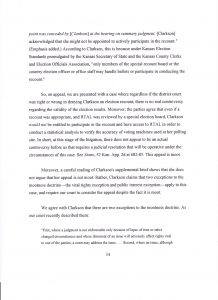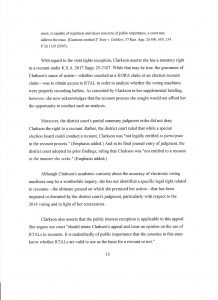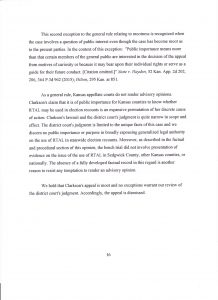The Appeals court said no. My attorney phrased it this way “This is a disappointing result.” I want to commend Randy Rathbun for his handling of this suit. He has been nothing but professional, providing his excellent services entirely pro bono on this effort.
A Day at the Legislature
Friday, I took vacation time from work and spent the day listening and testifying at the Oct 27th meeting of the Joint committee on Ethics and Election in Topeka. I want to thank all the people who have donated to the Show Me The Votes Foundation. While the travel expenses are small, the knowledge that I don’t have to take on the costs personally and that I am speaking for others as well as myself provides significant motivation for me to do this.
The majority of the day was scheduled with people from non-profit agencies talking about the joys of Ranked Choice Voting. They were all very professional and did a decent job of covering the cons as well as the pros. I actually found it all fairly interesting. It turns out that one of the unintended consequences of ranked choice voting was a decrease in negative campaigning because insulting an opponent supported by a voter doesn’t incline that voter to making you their second choice. A big plus for the method in my opinion, but that opinion was not shared by all of the committee members.
One senator was confused by a technical detail regarding a theoretical situation that could result in a sub-optimal outcome (one of the cons presented). I don’t think the presenter quite managed to understand his confusion well enough to alleviate it. My take on it was that the senator didn’t realize that in the ranked choice system, a guy who is ranked 3rd is presumed to beat the guy ranked 6th if they were in a head-to-head match-up. This is a reasonable assumption in ranked choice voting because we are referring to the choices of an individual voter. Election outcomes are well established as potentially intransitive in 3-way versus head-to-head matchups, so it was not an unreasonable question for the senator to pose. (Intransitive relations are situations where A > B and B > C does NOT imply A > C)
Understanding and illuminating those underlying assumptions can be difficult. This case involved a deeply buried mathematical assumption about the elemental structure of the data and the answer that justifies it relates to a technical detail regarding the data collection in this context. I have been on both sides of such mathematical confusion, so I could sympathize with both. It’s not easy to identify the buried assumption that isn’t shared.
There were two other Kansans, both with math backgrounds, who testified about ranked choice voting. I was nominally in favor of it. Ranked choice voting is a method with a higher probability of providing a government representative of the majority will of the voters. It’s also more complicated to compute and may require substantially more time to arrive at a winner. As far as I’m concerned, it’s putting lipstick on a pig if they don’t address the elephant the room regarding voting machines, which is what I was there to tell them about.
I told the committee flat out that my research, currently under peer review, show that our machines are being manipulated and they needed to do something about that. I could be proved wrong with an audit, except … no audits allowed.
I complained about the fact that in Sedgwick County we have a brand new expensive voting machine system with a paper trail. Our election officials insist that without a legislative solution, those ballots may never be opened and reviewed by human eyes to verify the accuracy of the count. Which is pretty much what the appeals court judge told me back in September when I asked what voters could do to hold our officials accountable. I think I made it clear to the committee that the current situation was unacceptable.
They mentioned an audit bill that got passed last year. I made it clear that audits were not enough! We need transparent accurate counts election night*. Audits only tell us how off the results were and predict if outcomes were impacted. They don’t fix anything and they don’t prevent anything. We have to do that part too.
I am writing the ideas I hope I conveyed. I’m more eloquent on the internet that I am in person. I was dorky and awkward as always. I’ve accepted that about myself and my usual audience (engineers and/or math students) are fairly tolerant of my missing social cues as long as my math is good. But this was not my usual audience.
I got chided by the Chair about speaking off-topic. I got a lecture by Senator Miller about the unreliability of exit polls – which included a well-delivered “ma’am” that shut me off when I tried to interrupt him. Senator Faust-Goudeau, who had encouraged me to come, publicly thanked me for my testimony.
A few ladies from the League of Women Voters and Representative Elizabeth Bishop from my district came and sat in on my speech for moral support. All-in-all, it went about as well as talking about the elephant in the room usually does.
Rather than making a break for the door and heading home as soon as I finished my testimony, I swallowed my introvert instinct and hung around until the session was over and spoke with some of the committee members afterwards.
Sen. Miller expressed how he agrees with me about the audits. I acknowledged that audits are better. They were my first choice after all. He doesn’t think that exit polls should be taken seriously but acknowledged it’s the best data available to Kansas voters.
Senator Faust-Goudeau asked me to help prepare a bill to get the transparency we need to have confidence in election outcomes. She has given me a spark of hope that if I work at it, change might happen. She is one awesome lady! We are very lucky to have her working for Kansans.
*I wish I had thought to say whenever the winners are announced. One of the cons of the Ranked Choice Voting system is that it may require a couple of days to collect and compute the winner of a statewide race done with that system in place. It’s a drawback I could live with to get more representative outcomes in our elections.
Testimony for the Oct 27th meeting of the Joint committee on Ethics and Election
Ranked Choice Voting – Excellent Idea! But only if combined with secure and transparent vote counting processes.
My name is Beth Clarkson. I am a lifelong Kansas, born in Wichita. I hold a Ph.D. in statistics and have been certified as a quality engineer by the American Society for Quality for the past 30 years. Over the past several years, I have become more and more concerned about the accuracy of our voting machines, which has never been evaluated post-election via a hand count of election results. I have attempted to get access to the records needed to perform an audit of our voting machines more than once over the past several years but been told no every single time.
Having failed to receive permission to do an audit, on Nov 8th 2016 , with the help of volunteers, set up citizen’s exit polls for five locations in south central Kansas. This was our attempt to find out the accuracy of our voting machines.
I’m afraid that the evidence from those exit polls point overwhelmingly to our voting machines being manipulated. Not by enough to alter any outcomes in the races studied – the maximum deviation between our exit polls and the official results was less than 5% in suspect races. But still extremely troubling to me as a voting citizen of Kansas. I have submitted these results and my conclusions for peer review. I will be happy to provide an electronic copy of this paper on request. Today, I will simply summarize the findings.
A common question I get regarding these findings is “Couldn’t your results be due Republicans being less likely to fill out the exit poll survey?” The answer to that question lies in the patterns shown in the different races. Whilst certainty is never forthcoming from statistical analysis, the hypothesis that ‘Party X member respond to surveys at a different rate than others’ is a plausible explanation for only the Libertarian Party in two races. It does suffice for any others.
There are a number of statistically significant differences between our exit poll results and the official results, randomly scattered through the five locations and both methods (voting machines and paper ballots counted electronically). The scattered anomalies found are likely due to issues of process reliability without cause to suspect malicious intent. Of course, all anomalous findings should be investigated to determine the cause and appropriate corrective action because whether deliberate or inadvertent, the errors indicate that the election results might have been compromised. That won’t be happening though. The output of electronic voting equipment in Kansas is never verified post-election.
The results for the Presidential race look very suspicious. In Wichita and Winfield, four out the five sites, votes appear to be shifted from Clinton to Trump. Results in the fifth site, Wellington, showed substantial errors in the opposite direction. Results for the four Supreme Court justices opposed by Governor Brownback show a similar pattern nearly double in magnitude. This is not plausibly due to Republicans and Democrats having different propensities to respond to the Exit poll. If that were the case, we would see the same pattern in all locations and methods and races. We don’t. This looks like malicious tampering of the results by at least two different parties with opposite intentions.
These findings could be easily proven wrong with an audit of the results in those locations, except that only Sedgwick County has a paper trail. A paper trail that is, apparently, forbidden ever to be seen by human eyes.
Our machines should not be considered trustworthy without having a paper trail and verifying the count afterwards. These steps are the minimal precautionary measures needed according to the testimony of Dr. Andrew Appel of Princeton University to the Presidential Advisory Commission on Election Integrity Resources last month.
Sedgwick County purchased new machines and placed them in use in the special election in April. Immediately after the election and several times since then, via phone and email, I inquired of the Sedgwick County Elections office regarding what verification or auditing of the results of these new machines has been done or planned. I received the following response last week:
“State statutes have not changed regarding the ability of an election official to conduct post-election audits of voting equipment. Until such time as that occurs, we are unable to audit the voting equipment. Sedgwick County and this office strongly support legislation that permits post-election audits but this is a matter to be decided in the state legislature.” email on Oct 19, 2017 from Sandra L. Gritz, Chief Deputy Election Commissioner, Sedgwick County Election Office
Democracy requires transparency in the vote count. We don’t have that. New machines that aren’t verified are not an improvement. Citizens, such as myself, have no cause to have faith in the reported results. Further, faith in the reported electronically computed election results require verification done in a transparent and secure manner because audits can be rigged as easily as voting machines.
If this sounds crazy, I would remind the committee of the 2015 diesel emission cheating scandal, in which VW was caught installing secret software in more than half a million vehicles sold in the US that it used to fool exhaust emissions tests. Pre-election testing of the voting machines is not sufficient to guarantee accuracy.
Equifax is merely the latest in the seemingly endless procession of data breaches, which includes multi-national corporations as well as federal and state agencies including the CIA, the NSA, US Postal Regulatory Commission, the US Department of Housing and Urban Development, the Health Resources and Services Administration, the National Oceanic and Atmospheric Administration, and the U.S. Election Assistance Commission. That last, the Election Assistance Commission is mandated, among its many other responsibilities, with testing and certifying voting equipment.
As our elected representatives overseeing the voting process, I hope you will rectify this situation and allow all Kansas voters the right to see and count ballots for themselves or to see them counted by someone they find trustworthy. Transparency means having a paper trail and allowing voters access to that paper trail.
You may contact me for more information or a copy of my journal paper at Beth@bethclarkson.com
Provisional Voters Analysis
The Difference between Provisional Votes and Counted Votes in November 2016 Exit Poll
Before examining the exit poll results for provisional voters and counted voters, it is worth noting that for the five sites we collected data on, the percent of provisional voters with respect to the total number of counted votes has a near perfect correlation with the percent of registered Party Members for those sites (see Table below). The Democrats had a correlation of 0.9677, while the correlation was slightly higher for both the Republicans in the opposite direction. The party percentages are not independent of each other, so we expect similar correlations.
The Winfield results are not included in this analysis due to the low number (13) of provisional ballot surveys from that site. Urban Wichita is included because the concern regarding paper ballots being contaminated with provisional ballot voters will, even if true, decrease the probability of finding statistically significant differences between the provisional ballot votes and the counted votes.
Contamination the other direction is a concern for SE and SW Wichita as they have higher rates of provisional ballot voters than other voters. Contamination either direction will dilute the probability of seeing a statistically significant difference, it will not increase the probability of a type I error, so conclusions of statistically significant differences will hold even if some erroneous mixing of the groups occurred due to respondent error.
These results are also independent of any latent response bias in the survey sample due to party affiliation. If there was a party bias to responding the exit poll, it could be presumed consistent relative to being found unregistered or without adequate ID, thus necessitating a provisional vote. Results are shown below.
| Site | Total Votes | Prov Votes | Prov Vote % | % Reg Rep | % Reg Dem | % Reg Lib | Exit Poll Prov | % Prov | % Exit Poll |
|---|---|---|---|---|---|---|---|---|---|
| SW | 1796 | 78 | 4.34 | 43.33 | 17.17 | 1.06 | 79 | 101.3 | 5.51 |
| SE | 1323 | 92 | 6.95 | 29.04 | 30.39 | 0.95 | 79 | 85.87 | 8.54 |
| Urb | 1113 | 160 | 14.38 | 8.58 | 54.79 | 0.52 | 101 | 63.13 | 11.44 |
| Win | 2494 | 89 | 3.57 | 45.54 | 24.95 | 0.70 | 49 | 55.06 | 3.20 |
| Well | 2280 | 81 | 3.55 | 47.01 | 21.78 | 0.75 | 13 | 16.05 | 2.20 |
We can use the binomial test for the provisional versus counted ballots. They are two separate samples and one is not a subset of the other, which rules out the hypergeometric test used with the machine and paper ballots analysis. The binomial test was done for each candidate and judge response with the results shown below in Table 11.
The differences in vote share between the provisional and the counted voters in the exit poll will fit student’s t-distribution. We will determine if the provisional voters in our exit poll were statistically significantly different from registered voters with proper ID.
There isn’t sufficient data to warrant reporting results for the Independent candidate or the Green party candidate. The candidate differences are not independent within a race (they will sum to zero) but the results for the three candidate races are independent of each other.
Each Judge is an independent contest relative to the other four judges and the three candidate races.
A paired t-test was performed on the vote share ratios for the Republican, Democrat and Libertarian candidates in all three candidate races and another for the yes, no, and blank responses for the five judges to determine if there was any bias with respect to any particular party or retention vote.
| Response | Avg Diff | LCL* | UCL* | p-value |
|---|---|---|---|---|
| Democrat | 0.20% | -3.19% | 3.58% | 0.9008 |
| Libertarian | -2.45% | -4.31% | -0.59% | 0.0146 |
| Republican | 5.11% | 1.81% | 8.41% | 0.0058 |
| Other/Blank | -1.96% | -4.14% | 0.22% | 0.0729 |
| Judges – Yes | 7.93% | 5.67% | 10.19% | <0.0001 |
| Judges – No | 1.03% | -1.66% | 3.72% | 0.4313 |
| Judges – Blank | -8.96% | -10.64% | -7.29% | <0.0001 |
Republicans show a statistically significant difference with provisional voters being between 1.81% and 8.41% (average 5.11%) less likely to vote for Republican candidates compared to voters whose ballots were counted that day.
Libertarians show a statistically significant difference using the t-test with an increase between 0.59% and 4.31% (average 5.11%) in vote share from the provisional voters.
Neither the Democrats nor the ‘Write in/Left Blank” responders showed a statistically significant difference across the four sites and three races between the provisional voters and the regular voters with the t-test.
Provisional votes for the Kansas Supreme Court Justices show a distinct pattern of provisional voters being nearly 8% (average 7.93%) less likely to vote yes for all judges than the counted voters and nearly 9% (average 8.96%) more likely to indicate that they did not vote in that contest. The uncounted provisional ballots would not have altered the outcome of the races studied.
*LCL and UCL refer to the Lower and Upper Limits of the 95% Confidence Interval. If one is positive and the other negative, then we can presume there is no statistically significant difference between the counted voters and the provisional voters.
The Clarkson Curse – Never seen this happen before!
I recently received the following email from my lawyer’s para:
Randy asked me to send you the attached order from the Court of Appeals requiring supplemental briefing. He said to tell you this has never happened to him before.
Order for Supplemental Briefing
We Clarksons, or at least the branch I belong to, have a long-running family joke about a family curse. The key words are something like “This has never happened before” being uttered to us by professionals, usually involved with major repairs. This time, it’s extra work for no pay for my attorney, Randy Rathbun. I want to thank him for his continued efforts on this case. I’d have given it up before now if he weren’t there.
My reading of this order – keeping in mind that I am, in Randy’s opinion, a terrible lawyer – is that they are looking for an excuse to call it a moot question and boot it off their agenda as not worth their time. I’ve no idea how this will play out, but I trust Mr. Rathbun to do his best. Thanks for your continued interest and support.
